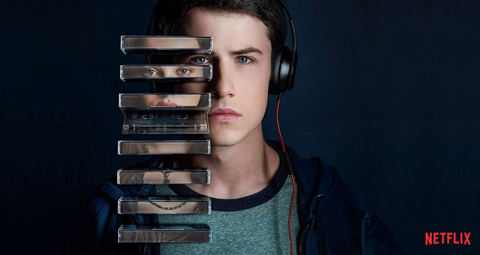May 5 | ![]() 0 COMMENTS
0 COMMENTS ![]() print
print

The Uncomfortable assumptions behind Netflix’s new suicide drama
AMANDA CONNELLY critiques the video streaming site’s controversial latest mystery teen series 13 Reasons Why
In the past few years Netflix has become a daily part of life in millions of homes all over the world. Yet there’s precious little scrutiny of just what the entertainment giant is pumping into our homes. One new series gripping teens and young adults across the world suggests it may not all be healthy.
13 Reasons Why, Netflix’s latest offering to its masses of subscribers, has seen viewers gripped by cliffhanger episode endings and a compellingly mysterious plotline. With its much-coveted five-star rating and the amount of fuss made over the show, it’s one I found even myself adding to my list of series to watch. Good write-up, young adult target audience and a bit of a mystery plotline—sounds ideal surely? Unfortunately, despite the series’ massive popularity, 13 Reasons Why is a show fraught with a number of serious faults.
Based on the 2007 book of the same title, the series charts the story of high school student Hannah Baker, who leaves behind 13 cassette tapes after killing herself, each tape featuring a different person in her school and subsequently their role as one of the reasons as to why she chose to end her life.
To some, the story of the fictional Hannah Baker is perhaps nothing more than a riveting plotline that keeps them occupied when they’re studying for an upcoming exam, or when lying in bed at 1am while they’re supposed to be sleeping. Yet for each of the 13 reasons Hannah Baker’s character chose to take her own life, there are at least 13 more problems to do with the series and how it portrays the subject of mental illness and suicide.
The subject of suicide is one that has been faced with difficulty across the years, both in and out of the Catholic Church. Yet while it can be argued the series brings the topic of mental illness and suicide to the forefront of conversation—particularly in young adults where there is a growing suicide risk within this age bracket—it surely becomes problematic when discussing the importance of valuing one’s life as a gift.
The Catholic Church has long been known for its pro-life stance and efforts towards this cause. The Church and many active groups within it is no stranger to promoting the sanctity of life. As St Mother Theresa herself was quoted as saying: “Life is life, fight for it.” The Church’s pro-life stance sees the promotion of life at the beginning, the end and everything in between.
While there is a particular focus on the pro-life cause for infants in the womb and for the elderly and sick with regards to issues such as euthanasia, there is perhaps a need too to look out for the promotion of pro-life work for teenagers and young adults, where suicide rates have increased in recent years among the age group.
13 Reasons Why could have been an opportunity to promote an anti-suicide message among our world’s young people. Instead, it turned the serious subject of suicide and the loss of beautiful life into something that is simply dispensable and fit solely for the purpose of TV entertainment.
Throughout the series, Hannah is seen to blame her suicide on 13 other young people with whom she attends school. And while their negative behaviour may have influenced Hannah’s internal negativity, the choice for her to commit suicide was all her own. The series is therefore suggesting that blame can simply be passed on to another person.
In addition to the somewhat poor treatment of suicide, the series also graphically depicts the act itself (a move that producers were advised against by a number of mental health charities) and features little discussion of the subject of mental health or any presentation of how mental health treatment can be beneficial. Despite its claims to bring mental illness in young adults to the centre of conversations for positive outcomes, 13 Reasons Why unfortunately is seen to contribute to the growing culture of death we see gradually increasing across the world.
The international youth ministry programme, Life Teen, produced a video and written message for young people who intend to watch the show. “Nowhere in the series is mental illness explicitly discussed or dealt with and the audience is left having been told that the people around Hannah Baker are responsible for her death because of their actions or lack thereof,” Life Teen’s Leah Murphy said. “While bullying, not saying anything when you see depressive or suicidal signs, and sexual assault are serious issues and can drive people to suicide, the reality is that suicide is rarely something avoided by good sentiments alone.”
“It’s been reported that 90 per cent of all suicides are committed by people who experience diagnosable mental illnesses. The vast majority of suicides can be traced to actual health issues, not just bullying or traumatic events.
“These health issues—actual, mental illnesses—require a lot more than the presence of a good friend or the absence of any serious issues or struggles—they require serious, professional help.
“Suicide will always be incredibly hurtful to countless individuals, but most tragically hurtful to the person who takes his or her own life—a life that was meant to continue, that was full of meaning, purpose, and infinite worth.”
It can’t be said the series itself is all bad. It certainly brings into the light the subjects of teen suicide, bullying and sexual assault for discussion, and ultimately puts forward the very real message that you do not know who may be suicidal and the devastating impact this act can have.
Yet for all its positives, the negatives cannot simply be ignored. This romanticised TV portrayal of suicide lacks essential mental health-positive messages and fails to stress that suicide is not the answer—a vitally important fact when there’s a growing suicide risk within the age group of the show’s target audience.
Catholic psychologist at St Raphael Counselling in Denver, Dr Jim Langley, has both read and watched 13 Reasons Why, and felt the show took a step too far in the ways it portrayed others as being at fault for Hannah’s suicide.
“To some degree we all have responsibility to other people, but in some ways the show goes too far, and makes it sound like we have responsibility for the other person,” he said. “We’re responsible to the people in our lives, to treat them well. But the people who hurt [Hannah] were not responsible for her choosing to commit suicide.”
“Most people who commit suicide—almost everyone—has a severe mental health problem. And the show does not portray this girl as having severe mental health problems in the way that somebody who is contemplating suicide almost always has.”
Instead, 13 Reasons Why conveys taking one’s own life as a revenge tactic, failing to accurately depict the reality of suicide for the many, many individuals across the world for who suicide is a major part of their life, in one way or another.
Dr Langley encouraged adults to speak to children and young people around them about the show, suicide and other issues.
“I think that especially with teenagers, they are exposed to so much in today’s culture that it’s our job as parents [to educate them] about those things and to provide real, accurate information and to provide them with the truth,” he said, noting that while adults may worry about over-exposing their children to serious issues, social media, the internet and the culture in which we live has already done that for the most part. “So as parents and educators, we’re not over-exposing them by talking about the issues, we’re going to help them process it and discern the truth in it. And I think it is really valuable to talk with teenagers about mental health issues.”
“It’s so important for parents to play a really active role in their kids’ lives. Even though a teenager’s number one priority is to individuate from mum and dad, which is healthy, you still have to be involved and talk with them and let them know that you care and that you’re invested in them,” he said. “Don’t be those absent parents that Hannah’s parents appeared to be in the show.”
It could perhaps be seen as a brave attempt to address the subject of teen suicide by the creators of the show, but 13 Reasons Why simply falls short. One thing Netflix’s newest programme has got right though? It shows just why we need more accurate depictions of young people with mental health issues, but ones that value the gift of life.











